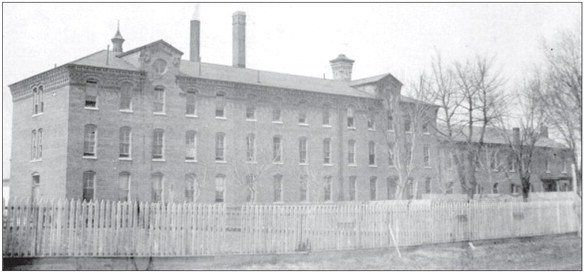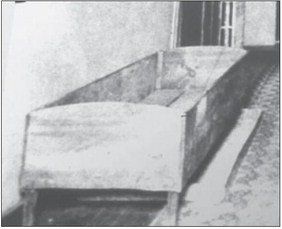The unfathomable case of Rhoda Derry

Committed to the Adams County Almshouse from 1860 to 1904, Rhoda Derry
scratched out her own eyes, punched out her own teeth, and ate anything she
could get her hands on.
The description sounds incomprehensible – what is the rest of the story?
How were the indigent, insane, or the unfortunate treated in the first century
of local city and county history? What housing conditions did Rhoda Derry
experience?
Poorhouses, originally called almshouses, were also called poor farms and by
1917 county homes. They were tax-supported residential institutions that took in
those who could not support themselves.
Public care of the poor in Illinois started in 1819, one year after Illinois
became a state. The destitute were cared for by private citizens appointed by
county officials. Within 20 years the farm-out system was replaced, and in 1839
county courts could establish poorhouses that also took in those persons of
“bodily infirmity, idiocy, or other unavoidable cause.” In 1847 Adams County
purchased the 80-acre farm of H. T. Ellis in Honey Creek Township for a poor
farm. By May 1855 a larger farm was purchased in Gilmer Township. County
records were mandated in 1874 to show admission, discharge, place of birth,
cause of the dependence and other vital data.
Rhoda Derry, the daughter of Jacob and Rachel Derry of Lima Township, was
admitted to the almshouse on Sept. 3, 1860. This came after a short stay at the
Jacksonville Mental Hospital where she was deemed incurable and sent home. When
her parents could no longer care for their daughter, she was sent to the
almshouse located almost three miles southwest of Coatsburg. The 1870 Adams
County census shows Rhoda at the almshouse at age 35 and noted she was blind
and insane. Born in Madison County, Ind., on Oct. 10, 1834, she would have been
25 when admitted in 1860. Rhoda had shown signs of mental illness since she was
18.
A report from county poorhouse records to the General Assembly of Illinois in
1881 indicated there were 101 inmates of whom 36 were considered insane paupers.
The report stated that the female patient (Rhoda) who “occupies a large wooden
box filled with straw will not wear clothing, is covered with a canvass cloth,
is in constant motion, has bruised herself from head to foot, and put out her
own eyes.”

What was Rhoda’s story? Was she bewitched as she believed? In her late teen years, Rhoda fell in love with a neighbor boy, Charles Phenix. His mother, thinking that the Derry family had associations with witchcraft, did not want her son to marry Miss Derry. The rumored connection to witchcraft went back to Rhoda’s grandmother, Mary Derry of Pennsylvania. This story has been told in “Rhoda, A Tragic and True Story of a Farmer’s Daughter” by D. Doc Derry.
When marriage plans to Rhoda became known to Charles’s mother, the legend is that she threatened to bewitch Rhoda if she didn’t leave Charles alone. Rhoda had a fear of witches, and some believe this event was the foundation of her madness. What caused the initial stages of her decline will never be known.
What happened to this unfortunate woman is part of Adams County history as is the work of renowned folklorist, Anglican minister and Quincy native, Harry M. Hyatt, who gathered 95 percent of the data for his book, “Folk-Lore from Adams County, Illinois,” within 10 miles of Quincy. The rare published collection documented American superstitions and tales of witchcraft that were prevalent in this limited geographical area.
The Adams County Poor Farm was not equipped to care for the mentally ill. Reports of poor conditions surfaced in the newspapers from time to time. A Quincy Daily Journal story on Feb. 12, 1892, pointed to abuses including underfed and neglected inmates. The same report further indicates a “simple-minded woman had charge of the insane woman’s department, food distribution etc.” Rhoda Derry survived inhumane and unfathomable circumstances over more than four decades of extreme confinement. Shortly after the turn of the century her tragic story would dramatically and forever change state and national practices for the mentally ill.
For years Rhoda lived in a basket of straw. Reports from the Adams County home show that during this time her limbs became drawn up until her knees almost touched her chin. After a time, the basket was replaced with a square box on legs. The box had holes for her excretions to drop below. Mice and other vermin made their nests at her side. It was under these conditions that her long fingernails grew and she scratched out her eyes. With her fists she beat her face until she lost all her front teeth.
Her case became public when she was sent to the Bartonville Asylum west of Peoria in 1904. Dr. George A. Zeller, a physician, champion of the mentally disturbed and superintendent of the new facility, was aware of Rhoda from annual reports to the state board and wrote, “Send her along, God bless her.” At the asylum she lived for the first time in a bed and was bathed daily.
The Quincy Daily Whig of Sept. 21, 1904, reported her relocation to Bartonville with “Renews Stories of Witchcraft” and stated, “Her case is one which calls forth the fullest sympathy from the coldest heart, and all marvel at the longevity of a human being in her condition and with her afflictions.”
Adams County attorney, James N. Sprigg, prepared the papers for the move. He asked Benjamin Bragg of Lima who had lived in the former home of the Derry family for information concerning her life. Bragg had known the daughter since 1851. Bragg recounted that Rachel Derry would often shoot at the imaginary evil spirits, which she believed were the cause of her daughter’s suffering. By 1904 Rhoda’s parents and six of her seven siblings were dead. A brother James and his wife Mary lived in Quincy from 1905 to 1910.
Under Dr. Zeller’s oversight Rhoda received humane care; Zeller was the only living person to whom she responded. During the two years before her death Dr. Zeller invited state legislators to view Rhoda and to secure greater services for the mentally disabled.
When Rhoda died Oct. 9, 1906, one day shy of her 72nd birthday, Dr. Zeller wrote to the Honorable S. B. McCrory, judge of the Adams County court, to inform him of her death. He wrote that the “passing of this most unfortunate woman calls for more than formal notice, as she was alone in her class and it is not likely that her duplicate could be found in the United States or in the world.” Rhoda was buried in grave number 217 on the grounds of the institution. In 1909 the Bartonville Asylum became the Peoria State Hospital.
Iris Nelson is reference librarian and archivist at Quincy Public Library, a civic volunteer, and member of the Lincoln-Douglas Debate Interpretive Center Advisory Board and other historical organizations. She is a local historian and author.
Sources
Derry, D. Doc. Rachel, The Tragic and True Story of a Farmer's Daughter. (no place): Tanner River Publishing, 2011.
"Food for the Paupers." Quincy Whig. January 28, 1892.
Genosky, Landry, ed. People's history of Quincy and Adams County, Illinois : a Sesquicentennial History. Quincy, IL: Jost & Kiefer Print Co., 1974.
Illinois State Archives. "Adams County Almshouse Register Index (1873-1898)."
http://www.cyberdriveillinois.com/departments/archives/databases/adams
"Methods in Vogue." Quincy Daily Journal. March 21, 1907.
"Mysterious Rhoda Derry." Quincy Daily Journal. November 23, 1906.
"Rhoda Derry's Case Is Most Remarkable." Quincy Daily Whig. November 7, 1906
"Rhoda Derry at Bartonville." Quincy Daily Journal. September 21, 1904.
"Should Be Ousted." Quincy Daily Journal. February 12, 189






